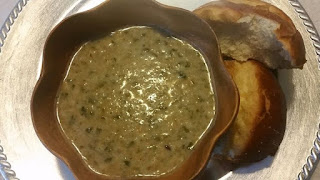Looking to add a little late Medieval flair to your morning routine? These five hearty, historical dishes—from hand pies to fairy-pink porridge—are drawn directly from period sources and reimagined for your modern kitchen. Each one links to the full recipe. Bon appétit, or as they might have said: “God spede the plough!”
A Fryed Meate (Pancakes) in Haste for the Second Course (The Whole Body of Cookery Dissected, 1682) - cottage cheese and apples combined with warm and sweet spices create a delicate pancake. Traditionally served in the second course, this dish would make a lovely camp breakfast. A bit late for Medieval, yes, delicious and to be tried all the same.
 Gammon of Bacon (A Book of Cookrye, 1591) - This is a delicious savory tidbit that creates a lovely hand pie which tastes like a holiday in a pie crust. Gammon, like ham, comes from the hind leg of a pig. Unlike ham, gammon is cured like bacon and sold raw. For this recipe I used a heritage cured ham, seasoned with pepper, cloves and mace, cut into thin slices and stuffed with parsley, sage and hardboiled egg yolks, cut to fit into the pie crust, dotted with butter and baked. A wonderful interpretation of our past, a must try for any foodie, food historian or hungry cook!
Gammon of Bacon (A Book of Cookrye, 1591) - This is a delicious savory tidbit that creates a lovely hand pie which tastes like a holiday in a pie crust. Gammon, like ham, comes from the hind leg of a pig. Unlike ham, gammon is cured like bacon and sold raw. For this recipe I used a heritage cured ham, seasoned with pepper, cloves and mace, cut into thin slices and stuffed with parsley, sage and hardboiled egg yolks, cut to fit into the pie crust, dotted with butter and baked. A wonderful interpretation of our past, a must try for any foodie, food historian or hungry cook!


🍽️ Bonus Breakfast Dishes from the Archives
Looking to expand your medieval breakfast repertoire? Here are a few more period-perfect options worth exploring:
- Crème Boylede – A spiced almond custard thickened with egg yolks, perfect served warm on cold mornings.
- Drawyn Grwel – A savory grain-based gruel enriched with meat broth, spices, and sometimes marrow or blood for depth and nourishment.
- Rede Rose – A honeyed almond pudding flavored with rosewater and colored pink with saunders—elegant, delicate, and deeply comforting.
These dishes offer a broader glimpse into how people in the medieval and early modern worlds began their day—with warmth, spice, and a touch of ceremony.
🍽 Explore More Medieval Breakfast Recipes:
- Rastons – Egg-enriched bread for soaking in broth
- Soupes Dorye – Toasted bread in spiced almond milk
- Lyode Soppes – Early custard-style bread pudding
- Soupes Jamberlayne – Bread soaked in mulled wine
- Egges yn Brewte – Poached eggs in spiced broth
- Eyron en Poche – Poached eggs with herbs in sauce
- Pressmetzen zu Ostern – Spiced Lenten breakfast bread
- Spiced Apples and Pears – Stewed fruit with wine and spice
- Fennel and Bacon Bread – Rustic loaf with herbs and meat
- Frumenty and Venyson – Cracked wheat porridge with game
☕ Looking for even more morning inspiration?
Don’t miss the original article: Breakfast: Five Medieval Banquet Dishes »






